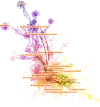Visualizing a field of research: A methodology of systematic scientometric reviews
- PMID: 31671124
- PMCID: PMC6822756
- DOI: 10.1371/journal.pone.0223994
Visualizing a field of research: A methodology of systematic scientometric reviews
Abstract
Systematic scientometric reviews, empowered by computational and visual analytic approaches, offer opportunities to improve the timeliness, accessibility, and reproducibility of studies of the literature of a field of research. On the other hand, effectively and adequately identifying the most representative body of scholarly publications as the basis of subsequent analyses remains a common bottleneck in the current practice. What can we do to reduce the risk of missing something potentially significant? How can we compare different search strategies in terms of the relevance and specificity of topical areas covered? In this study, we introduce a flexible and generic methodology based on a significant extension of the general conceptual framework of citation indexing for delineating the literature of a research field. The method, through cascading citation expansion, provides a practical connection between studies of science from local and global perspectives. We demonstrate an application of the methodology to the research of literature-based discovery (LBD) and compare five datasets constructed based on three use scenarios and corresponding retrieval strategies, namely a query-based lexical search (one dataset), forward expansions starting from a groundbreaking article of LBD (two datasets), and backward expansions starting from a recently published review article by a prominent expert in LBD (two datasets). We particularly discuss the relevance of areas captured by expansion processes with reference to the query-based scientometric visualization. The method used in this study for comparing bibliometric datasets is applicable to comparative studies of search strategies.
Conflict of interest statement
The authors have declared that no competing interests exist.
Figures












References
-
- Bruza P, Weeber M. Literature-Based Discovery: Springer; 2008.
-
- Sebastian Y, Siew E, Orimaye SO. Emerging approaches in literature-based discovery: techniques and performance review. The Knowledge Engineering Review. 2017;32(e12):1–35.
Publication types
MeSH terms
Associated data
LinkOut - more resources
Full Text Sources

